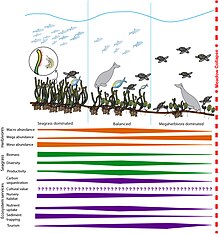
Back وفرة (علم البيئة) Arabic Abundància (ecologia) Catalan Abundanz (Ökologie) German Abundancia (ecología) Spanish Arvukus Estonian فراوانی (بومشناسی) Persian Abondance (écologie) French Líonmhaireacht (éiceolaíocht) Irish 존재비 Korean Abundantie (ecologie) Dutch

In ecology, local abundance is the relative representation of a species in a particular ecosystem.[1] It is usually measured as the number of individuals found per sample. The ratio of abundance of one species to one or multiple other species living in an ecosystem is referred to as relative species abundances.[1] Both indicators are relevant for computing biodiversity.
A variety of sampling methods are used to measure abundance. For larger animals, these may include spotlight counts, track counts and roadkill counts, as well as presence at monitoring stations.[2] In many plant communities the abundances of plant species are measured by plant cover, i.e. the relative area covered by different plant species in a small plot.[3] Abundance is in simplest terms usually measured by identifying and counting every individual of every species in a given sector. It is common for the distribution of species to be skewed so that a few species take up the bulk of individuals collected.[4]
Relative species abundance is calculated by dividing the number of species from one group by the total number of species from all groups.
- ^ a b Preston, F.W. (July 1948). "The Commonness, and Rarity, of Species" (PDF). Ecology. 29 (3): 254–283. doi:10.2307/1930989. JSTOR 1930989. Archived from the original (PDF) on 2014-12-22. Retrieved 2019-02-12 – via Ben-Gurion University of the Negev.
- ^ Wright, David Hamilton (July 1991). "Correlations Between Incidence and Abundance are Expected by Chance". Journal of Biogeography. 18 (4). Journal of Biogeography, Vol. 18, No. 4: 463–466. doi:10.2307/2845487. JSTOR 2845487.
- ^ Damgaard, Christian (2009). "On the distribution of plant abundance data". Ecological Informatics. 4 (2): 76–82. doi:10.1016/j.ecoinf.2009.02.002.
- ^ Cite error: The named reference
:3was invoked but never defined (see the help page).
© MMXXIII Rich X Search. We shall prevail. All rights reserved. Rich X Search